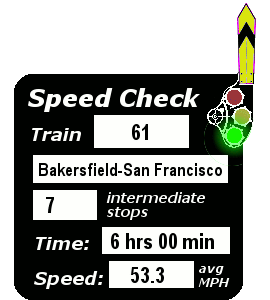



Time:
A - A.M.
D - Train stops only to discharge passengers
F - Conditional (Flag) stop
I - Customs/Immigration inspection stop
M - Meal stop
N - Not a passenger stop
P - P.M.
R - Train stops only to receive passengers
Services:
A - Auto loading/unloading facilities (as freight)
B - Checked baggage is handled
C - Coupon station (Ticket office)
I - International border inspection station
M - Food service available
P - Telephone station
R - Rental cars available
T - Telegraph station
X - Checked baggage NOT handled







Since the 19th century, the Southern Pacific had had a stranglehold on rail traffic between the major cities of the West Coast, specifically Los Angeles and San Francisco. True, the Santa Fe had won trackage rights over the Tehachapi Loop and entrance to San Francisco in 1900—but the Santa Fe's route between California's two largest cities ran far to the east through Barstow. Freight didn't complain, but passengers balked at having to travel 130-plus miles out of the way.
But in the late 1930s as the state of California was upgrading and modernizing its highway system, the Santa Fe saw its chance. The Santa Fe proposed a coordinated intermodal bus and rail service between Los Angeles and San Francisco. Air-conditioned, streamlined buses would transport passengers over the new highway between LA and Bakersfield, where they would board the Santa Fe's new, streamlined, diesel-powered Golden Gate. That train would transport the passengers to Oakland, from whence they would again board buses and travel to San Francisco across the newly completed Bay Bridge.
Southern Pacific did not take kindly to having its monopoly assaulted—to put things mildly. Nor did Pacific Greyhound Lines, an SP affiliate, welcome the thought of new competition. The respective companies fought a titanic battle before the California Railroad Commission which dragged out for almost two full years. Finally, on April 18, 1938, the Commission ruled in favor of the Santa Fe and the new Golden Gates entered service on July 1 of that same year.